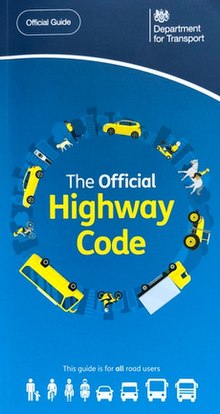
The Highway Code is the official set of information and guidance for road users in the United Kingdom. Its objective is to promote the safe and efficient use of the road network. The Code applies to all road users, including pedestrians, horse riders and cyclists, as well as motorcyclists and other drivers. It gives information on traffic signs, traffic signals, road markings and legal requirements for different road users, and has annexes on vehicle maintenance, licence requirements, documentation, penalties, and vehicle security.
Though The Highway Code itself is not legally binding, many of its rules directly reflect the law, and a failure to observe any of its provisions may be used as evidence in legal proceedings (especially to establish liability in relation to offences such as careless and dangerous driving).
The Highway Code was first published in 1931, and is regularly updated.[1] It is prepared by the Department for Transport and the Driver and Vehicle Standards Agency, and is published by The Stationery Office in both electronic form and as a printed book.
The 17th edition (2022) introduced some significant changes. In particular, a new "hierarchy of road users" classifies road users according to the danger they pose to others in the event of a collision, with the most vulnerable (for example, pedestrians and cyclists) at the top.
The Great Britain version, available in English and Welsh, applies to England, Scotland and Wales, but region-specific signs such as driver location signs in England and bilingual signs in Scotland and Wales are not covered. There is also a Northern Ireland version, available in English and Irish.
- ^ "The Highway Code - Introduction". UK Government Department for Transport. Web site updated to be always current.